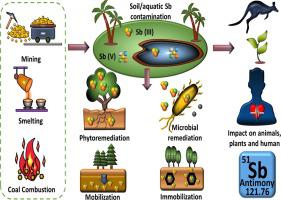当前位置:
X-MOL 学术
›
Environ. Int.
›
论文详情
Our official English website, www.x-mol.net, welcomes your
feedback! (Note: you will need to create a separate account there.)
Antimony contamination and its risk management in complex environmental settings: A review
Environment International ( IF 10.3 ) Pub Date : 2021-10-04 , DOI: 10.1016/j.envint.2021.106908 Nanthi Bolan 1 , Manish Kumar 2 , Ekta Singh 2 , Aman Kumar 2 , Lal Singh 2 , Sunil Kumar 2 , S Keerthanan 3 , Son A Hoang 4 , Ali El-Naggar 5 , Meththika Vithanage 3 , Binoy Sarkar 6 , Hasintha Wijesekara 7 , Saranga Diyabalanage 3 , Prasanthi Sooriyakumar 4 , Ajayan Vinu 4 , Hailong Wang 8 , M B Kirkham 9 , Sabry M Shaheen 10 , Jörg Rinklebe 11 , Kadambot H M Siddique 12
Environment International ( IF 10.3 ) Pub Date : 2021-10-04 , DOI: 10.1016/j.envint.2021.106908 Nanthi Bolan 1 , Manish Kumar 2 , Ekta Singh 2 , Aman Kumar 2 , Lal Singh 2 , Sunil Kumar 2 , S Keerthanan 3 , Son A Hoang 4 , Ali El-Naggar 5 , Meththika Vithanage 3 , Binoy Sarkar 6 , Hasintha Wijesekara 7 , Saranga Diyabalanage 3 , Prasanthi Sooriyakumar 4 , Ajayan Vinu 4 , Hailong Wang 8 , M B Kirkham 9 , Sabry M Shaheen 10 , Jörg Rinklebe 11 , Kadambot H M Siddique 12
Affiliation

|
Antimony (Sb) is introduced into soils, sediments, and aquatic environments from various sources such as weathering of sulfide ores, leaching of mining wastes, and anthropogenic activities. High Sb concentrations are toxic to ecosystems and potentially to public health via the accumulation in food chain. Although Sb is poisonous and carcinogenic to humans, the exact mechanisms causing toxicity still remain unclear. Most studies concerning the remediation of soils and aquatic environments contaminated with Sb have evaluated various amendments that reduce Sb bioavailability and toxicity. However, there is no comprehensive review on the biogeochemistry and transformation of Sb related to its remediation. Therefore, the present review summarizes: (1) the sources of Sb and its geochemical distribution and speciation in soils and aquatic environments, (2) the biogeochemical processes that govern Sb mobilization, bioavailability, toxicity in soils and aquatic environments, and possible threats to human and ecosystem health, and (3) the approaches used to remediate Sb-contaminated soils and water and mitigate potential environmental and health risks. Knowledge gaps and future research needs also are discussed. The review presents up-to-date knowledge about the fate of Sb in soils and aquatic environments and contributes to an important insight into the environmental hazards of Sb. The findings from the review should help to develop innovative and appropriate technologies for controlling Sb bioavailability and toxicity and sustainably managing Sb-polluted soils and water, subsequently minimizing its environmental and human health risks.
中文翻译:

复杂环境环境下的锑污染及其风险管理研究进展
锑 (Sb) 从各种来源引入土壤、沉积物和水生环境中,例如硫化物矿石的风化、采矿废料的浸出和人为活动。高浓度的 Sb 对生态系统有毒,并可能通过在食物链中积累对公共卫生造成毒性。尽管 Sb 对人类有毒且致癌,但引起毒性的确切机制仍不清楚。大多数关于修复受 Sb 污染的土壤和水生环境的研究都评估了降低 Sb 生物利用度和毒性的各种改良剂。然而,目前还没有关于 Sb 的生物地球化学和与其修复相关的转化的全面综述。因此,本综述总结了:(1) Sb 的来源及其在土壤和水生环境中的地球化学分布和形态,(2) 控制 Sb 动员、生物利用度、土壤和水生环境中的毒性以及对人类和生态系统健康可能构成的威胁的生物地球化学过程,以及 (3) 用于修复 Sb 污染的土壤和水并减轻潜在环境和健康风险的方法。还讨论了知识差距和未来的研究需求。本综述提供了有关 Sb 在土壤和水生环境中命运的最新知识,有助于深入了解 Sb 的环境危害。审查的结果应该有助于开发创新和适当的技术来控制 Sb 的生物利用度和毒性,可持续地管理受 Sb 污染的土壤和水,从而最大限度地减少其环境和人类健康风险。
更新日期:2021-10-04
中文翻译:

复杂环境环境下的锑污染及其风险管理研究进展
锑 (Sb) 从各种来源引入土壤、沉积物和水生环境中,例如硫化物矿石的风化、采矿废料的浸出和人为活动。高浓度的 Sb 对生态系统有毒,并可能通过在食物链中积累对公共卫生造成毒性。尽管 Sb 对人类有毒且致癌,但引起毒性的确切机制仍不清楚。大多数关于修复受 Sb 污染的土壤和水生环境的研究都评估了降低 Sb 生物利用度和毒性的各种改良剂。然而,目前还没有关于 Sb 的生物地球化学和与其修复相关的转化的全面综述。因此,本综述总结了:(1) Sb 的来源及其在土壤和水生环境中的地球化学分布和形态,(2) 控制 Sb 动员、生物利用度、土壤和水生环境中的毒性以及对人类和生态系统健康可能构成的威胁的生物地球化学过程,以及 (3) 用于修复 Sb 污染的土壤和水并减轻潜在环境和健康风险的方法。还讨论了知识差距和未来的研究需求。本综述提供了有关 Sb 在土壤和水生环境中命运的最新知识,有助于深入了解 Sb 的环境危害。审查的结果应该有助于开发创新和适当的技术来控制 Sb 的生物利用度和毒性,可持续地管理受 Sb 污染的土壤和水,从而最大限度地减少其环境和人类健康风险。































 京公网安备 11010802027423号
京公网安备 11010802027423号